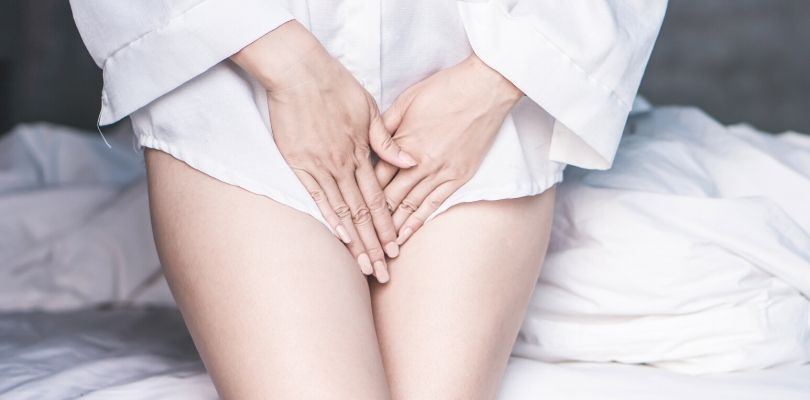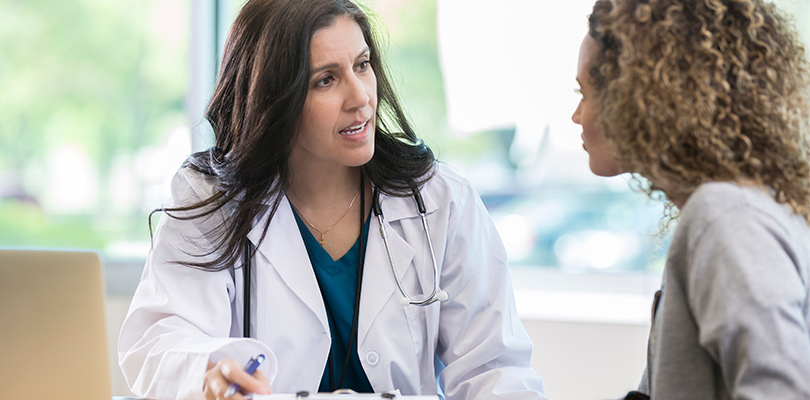All About Menopause: The Average Age of Menopause
Menopause is a natural physiologic process that happens to every woman during her life. The physical symptoms that are associated with menopause can be very disrupting to your life, sending you on an emotional and physical rollercoaster.
Learning effective ways to deal with the symptoms of menopause can help to decrease your symptoms and improve your quality of life during this stage of your life.
What Is Menopause?
“Menopause” is defined as the absence of menstrual periods for a period of 12 months and marks the end of a woman’s reproductive cycle.
When a woman is born, she has a set number of eggs stored in the ovaries. The ovaries also produce estrogen and progesterone, which are hormones that control ovulation and menstruation. Menopause occurs when the ovaries stop releasing an egg each month, thereby stopping menstruation.
Stages of Menopause
Menopause doesn’t happen rapidly, it’s a gradual process that occurs over many years and is typically divided into three stages:
- Perimenopause – this stage lasts until menopause. Perimenopause occurs as the ovaries start to make less estrogen and usually begins several years before menopause. The drop in estrogen happens rapidly in the last 1 to 2 years of this stage, and many women start to experience typical symptoms of menopause during this time.
- Menopause – this stage is defined when one year has passed since a woman has experienced a menstrual period. At this phase, the ovaries have almost stopped making estrogen and have stopped releasing eggs.
- Postmenopause – this stage involves the years after menopause has occurred. Symptoms of menopause usually ease for the majority of women during this phase. However, health risks associated with decreased estrogen increase as the woman ages.
When Does Menopause Occur?
Menopause is a normal part of the aging process for women that typically happens after the age of 40. However, some women may go through early menopause, termed “premature menopause.”
Studies have shown that the age when a woman reaches menopause varies by geographical location. The median age at menopause in various regions around the world is outlined below:
- North America 50.5 to 51.4 years
- Europe 50.1 to 52.8 years
- Latin America 43.8 to 53 years
- Asia 42.1 to 49.5 years
You might be questioning why the age at which menopause occurs is important – well, the age at menopause may be an indicator of aging and health. Research has shown that a later age at natural menopause has been associated with a variety of health effects, including:
- Longer life expectancy
- Reduced all-cause mortality
- Decreased risk of cardiovascular disease
- Decreased risk of death from cardiovascular disease, ischemic heart disease, myocardial infarction, atherosclerosis, and stroke
- Decreased bone density loss
- Reduced risk of osteoporosis and fractures
- Increased risk of female cancers (breast, ovarian, and endometrial)
What Causes Menopause?
While every woman will go through menopause, there are various factors that can affect when you will go through this stage of life.
Natural Decline of Reproductive Hormones
As you reach your late 30’s, your ovaries start making less progesterone and estrogen, which are the hormones that regulate menstruation. This leads to a decline in fertility.
When you reach your 40’s, you’ll start to notice changes in your periods – they may become heavier or lighter, shorter or longer, and may occur less frequently, up until the point when your ovaries stop releasing eggs and your periods cease.
Certain Surgeries
You can either have a total hysterectomy, which involves removal of both your ovaries and uterus, or a partial hysterectomy, which involves removal of only your uterus. While a total hysterectomy will result in immediate menopause, a partial procedure typically doesn’t cause immediate menopause.
Radiation or Chemotherapy
These therapies can initiate menopause in some individuals during, or shortly after, the course of treatment. The effect of these therapies on menstruation and fertility is not always permanent, so back up birth control methods are recommended.
Primary Ovarian Insufficiency
This occurs when your ovaries do not procedure a sufficient level of reproductive hormones and usually occurs due to autoimmune disease or genetic factors, leading to premature menopause.
In individuals with primary ovarian insufficiency, hormone replacement therapy is recommended until the normal age of menopause to provide protection to the heart, bones, and brain.
Signs and Symptoms of Perimenopause and Menopause
Each woman will experience menopause differently with some women experiencing few or no symptoms, and other women experiencing multiple symptoms. In some women, symptoms come and go over an extended period of time.
Below we’ll discuss some of the most common symptoms that women experience.
Menopause and pelvic floor dysfunction are often related and it is important to know the symptoms of each. Learn more here.
Irregular Vaginal Bleeding
While some women have minimal issues with abnormal bleeding leading up to menopause, others suffer irregular vaginal bleeding including periods that may become lighter or heavier than normal, or occur less often or more frequently than usual.
Additionally, women going through perimenopause may experience a menstrual period after going without one for several months. Irregular bleeding can continue for years before reaching menopause.
Irregular menstrual cycles are associated with decreased fertility; however, perimenopausal women can still become pregnant so birth control should be used until menopause has been reached if pregnancy is not desired.
If you’ve started experiencing irregular vaginal bleeding, speak with your doctor to confirm that it is due to perimenopause and not an underlying medical condition.
Hot Flashes and Night Sweats
Hot flashes are one of the characteristic symptoms of menopause. They involve a feeling of warmth over the whole body, although it is most pronounced in the chest and head, lasting from 30 seconds to several minutes.
For some women, hot flashes are associated with flushing of the face and at times can be followed by sweating. In some cases, hot flashes occur with night sweats, which may lead to sleep disturbances and daytime sleepiness.
Hot flashes are believed to be a combination of hormonal and physiological fluctuations in the body that are caused by decreasing levels of estrogen.
Hot flashes occur in approximately 40 percent of women in their 40’s that still have regular menstruation cycles, so they may actually start before menstrual irregularities begin.
After approximately five years, 80 percent of women stop having hot flashes, however, in about 10 percent of women, hot flashes can persist for up to 10 years. While there is no way to predict when hot flashes will stop, they often decrease in frequency over time, and severity of hot flashes tends to fluctuate.
Vaginal Issues
As estrogen levels fall, the tissue lining of the vagina becomes drier, thinner, and loses its elasticity. This can result in symptoms of vaginal irritation, itching, dryness, and/or pain during intercourse. These changes may also result in an increased risk of vaginal infection.
Urinary Issues
As estrogen levels fall, the lining of the urethra, which is the tube that transports urine from the bladder, undergoes similar changes to the vaginal tissue, becoming thinner, dryer, and less elastic.
These changes result in an increased risk of urinary issues including the urge to urinate more frequently, increased risk of urinary tract infections, and/or urinary incontinence.
Urinary incontinence is more likely to occur when there is a sudden, strong urge to urinate, or when the woman is straining such as what occurs during coughing, sneezing, or with heavy lifting.
Emotional and Cognitive Issues
Women going through perimenopause may report emotional and cognitive issues such as memory difficulties, irritability, fatigue, and/or mood swings.
Physical Changes
There are a variety of other physical changes that happen during perimenopause and menopause, including:
- Weight gain
- With body fat appearing in the waist and abdomen
- Skin changes
- Changes in skin texture, wrinkles, adult acne, etc.
- Hair growth
- Especially on the chin, upper lip, abdomen, and/or chest
Health Issues Associated with Menopause
Decreasing estrogen levels in menopause have been linked to a variety of health issues, including:
- Osteoporosis
- Bladder and bowel issues
- Heart disease
- Increased risk of Alzheimer’s disease
- Decreased skin elasticity
- Decreased muscle tone and strength
- Vision changes, including cataracts and macular degeneration
Menopause Treatment Options
Menopause is a normal process that doesn’t necessarily require treatment; however, some women have severe symptoms and look for treatment options to ease their symptoms. Below we’ll discuss some of the common treatment options used.
Hormone Therapy (HT)
The decision whether or not to take HT is an individual decision that needs to evaluate the risks versus benefit of treatment based on the woman’s symptoms and past medical history.
Current recommendations advise that if HT is used, it should be used at the lowest effective dose. We’ll discuss estrogen and progesterone hormone therapy and bio-identical hormone therapy.
Estrogen and Progesterone
Hormone therapy (also known as hormone replacement therapy (HRT) and postmenopausal hormone therapy (PHT)) involves a combination of estrogens and progesterone that help to control the symptoms of menopause that are attributed to decreasing estrogen levels, including vaginal dryness and hot flashes.
HT is available in a variety of options including oral, and transdermal form. Transdermal options do not affect the liver, therefore this route of HT administration is preferred by most women.
There are however side effects to HT – combined estrogen and progesterone therapy increases the risk of heart attack, stroke, and breast cancer. Estrogen therapy alone increases the risk of stroke and the development of endometrial cancer
Bio-identical Hormone Therapy
Bio-identical hormone therapies are medications that contain hormones that contain the same chemical formulation as those that are found naturally in the body. They are created in a laboratory setting by altering compounds that are derived from natural plant products.
Bio-identical hormone therapy is available in the transdermal form, in either a cream or gel formulation.
While many people believe that treatment with bio-identical hormones has the potential to avoid the serious side effects of synthetic HT, research is necessary to investigate the long-term effectiveness and safety of this treatment.
Oral Contraceptives
Oral contraceptives are another type of HT that is used to treat irregular vaginal bleeding in perimenopausal women. Oral contraceptives help to regulate menstruation, decrease hot flashes, and also provide birth control.
Vaginal Treatments
Local vaginal treatments are available, including the vaginal estrogen ring, vaginal estrogen tablets, and vaginal estrogen cream that can be applied directly to the vaginal area to treat the symptoms associated with decreasing estrogen levels. In some cases, local treatments are used in combination with oral estrogen therapy.
In cases of vaginal dryness, non-hormonal vaginal moisturizing creams and/or lotions, as well as lubricants can be used during intercourse to minimize discomfort.
In women that have vaginal symptoms after intercourse such as vaginal discomfort or burning, applying betadine to the outside of the vaginal area, or soaking in a warm bath may help to relieve symptoms.
Antidepressant Medications
Research has shown that a specific class of drugs, called serotonin reuptake inhibitors, may be effective in controlling hot flashes in up to 60 percent of women. Keep in mind that antidepressant medications carry side effects including sexual dysfunction and decreased sex drive.
Lifestyle Changes
Leading a healthy lifestyle can help to minimize, and may even help to avoid, symptoms of menopause. Some tips include:
- Exercise regularly.
- Consume a healthy, balanced diet.
- Quit smoking.
- Limit caffeine and alcohol.
Conclusion
Chances are you’ll suspect you’re entering the stage of menopause, or your doctor will, based on your signs and symptoms. It can really help if you track your menstrual cycle and chart the results down when they start to become irregular.
Don’t be shy to talk to your doctor about your symptoms if they’re negatively affecting your quality of life.
Signs and symptoms of menopause can be managed through lifestyle changes and other treatment options including hormone replacement therapy with synthetic or bio-identical hormones, oral contraceptives, vaginal treatments, and anti-depressant medications.







